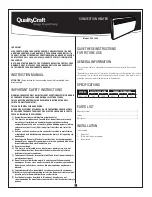
D5263
- SIL 2 Load Cell/Strain Gauge Bridge Isolating Repeater
G.M. International ISM0227-8
5
Start-up
Before powering the unit check that all wires are properly connected, particularly supply conductors and their polarity, input and output wires, also check that Intrinsically Safe conductors
and cable trays are segregated (no direct contacts with other non I.S. conductors) and identified either by color coding, preferably blue, or by marking.
Check conductors for exposed wires that could touch each other causing dangerous unwanted shorts.
Before turning power on, field load cell must be connected to the module.
Then, turn power on, the “power on” green led must be lit, the unit repeats the load cell condition, check
with the weighing indicator the proper value reading.
Installation
D5263 series is a Load Cell/Strain Gauge Bridge Isolating Repeater housed in a plastic enclosure suitable for installation on EN/IEC60715 TH 35 DIN-Rail, with or without Power Bus.
D5263 series can be mounted with any orientation over the entire ambient temperature range.
Electrical connections are accommodated by polarized plug-in removable screw terminal blocks which can be plugged in/out into a powered unit without suffering or causing any damage
(for Zone 2 installations check the area to be nonhazardous before servicing)
. Connect only one individual conductor per each clamping point, use conductors up to 2.5 mm²
(13 AWG) and a torque value of 0.5
-
0.6 Nm. Use only cables that are suitable for a temperature of at least 85°C.The wiring cables have to be proportionate in base to the current and the
length of the cable.
On the section “Function Diagram” and enclosure side a block diagram identifies all connections.
Identify the function and location of each connection terminal using the wiring diagram in the corresponding section, for example:
Connect a 24 Vdc power supply voltage between terminals “9” (positive pole) and “10” (negative pole).
Connect positive output at terminal “5” and negative output at “6”.
Connect host reference voltage at terminal “1” positive and terminal “4” negative.
If host system has remote voltage sensing capability, connect sensing wire at terminal “2” positive and terminal “3” negative.
Connect strain gauge bridge voltage supply at terminal “13” positive and terminal “16” negative.
Connect strain gauge bridge voltage sensing supply at terminal “14” positive and terminal “15” negative.
If strain gauge bridge has no internal voltage sensing capability always connect terminal "14" to terminal "13" and terminal "16" to terminal "15";
for better performance connect the wire at the end of the line near the load cells.
Connect strain gauge bridge output signal at terminal “17” positive and terminal “18” negative.
Intrinsically Safe conductors must be identified and segregated from non I.S. and wired in accordance to the relevant national/international installation standards (e.g. EN/IEC60079
-
14
Electrical apparatus for explosive gas atmospheres
-
Part 14: Electrical installations in hazardous areas (other than mines)), make sure that conductors are well isolated from each other
and do not produce any unintentional connection. Isolation in accordance with EN/IEC 60079
-
11 clause 6.3.13 is provided between non
-
intrinsically safe circuits and intrinsically safe
circuits.
The enclosure provides, according to EN60529, an IP20 minimum degree of protection (or similar to NEMA Standard 250 type 1). The equipment shall only be used in an area of at least
pollution degree 2, as defined in IEC 60664-1. When installed in EU Zone 2, the unit shall be installed in an enclosure that provides a minimum ingress protection of IP54 in accordance
with IEC 60079-0. The enclosure must have a door or cover accessible only by the use of a tool. The end user is responsible to ensure that the operating temperature of the module is
not exceeded in the end use application.
Units must be protected against dirt, dust, extreme mechanical (e.g. vibration, impact and shock) and thermal stress, and casual contacts. If enclosure needs to be cleaned use only a
cloth lightly moistened by a mixture of detergent in water.
Electrostatic Hazard: to avoid electrostatic hazard, the enclosure of D5263 series must be cleaned only with a damp or antistatic cloth.
Any penetration of cleaning liquid must be avoided to prevent damage to the unit.
Any unauthorized modification must be avoided.
D5263 series must be connected to SELV or PELV supplies.
All circuits connected to D5263 series must comply with the overvoltage category II (or better) according to EN/IEC60664
-
1.
D5263 series is an isolated Intrinsically Safe Associated Apparatus installed into standard EN/IEC60715 TH 35 DIN
-
Rail located in Safe Area or Zone 2, Group IIC, Temperature T4
Hazardous Area within the specified operating temperature limits Tamb –40 to +70 °C, and connected to equipment with a maximum limit for power supply Um of 250 Vrms or Vdc.
Not to be connected to control equipment that uses or generates more than 250 Vrms or Vdc with respect to earth ground.
D5263 series must be installed, operated and maintained only by qualified personnel, in accordance with the relevant national/international installation standards (e.g. IEC/EN60079-14
Electrical apparatus for explosive gas atmospheres - Part 14: Electrical installations in hazardous areas (other than mines)), following the established installation rules; particular care
must be given to segregation and clear identification of I.S. conductors from non I.S. ones.
De
-
energize power source (turn off power supply voltage) before plug or unplug the terminal blocks when installed in Hazardous Area or unless area is known to be nonhazardous.
Warning: substitution of components may impair Intrinsic Safety and suitability for Zone 2.
Explosion Hazard: to prevent ignition of flammable or combustible atmospheres, disconnect power before servicing or unless the area is known to be non-hazardous.
Failure to properly installation or use of the equipment may risk to damage the unit or severe personal injury.
The unit cannot be repaired by the end user and must be returned to the manufacturer or his authorized representative. Any unauthorized modification must be avoided.
Warning
Operation
The D5263 series strain gauge bridge isolating repeater acts as transparent galvanic isolated interface between weighing indicator in Safe Area/Non Hazardous Locations and a load cell
(or group of n load cells) installed in Hazardous Area/Hazardous Locations.
It provides a fully floating power supply voltage with remote sensing capability to strain gauge bridge and repeats the corresponding output signal.
Remote sensing wires (terminals “14” +Sense and “15” –Sense) must be always connected to force lines (terminals “13” +Exc and “16” –Exc) for proper operation of the unit, in case of
4 wires cell connect the sensing lines near to the cell connections to minimize the power supply voltage compensation error.
The mV input signal is isolated and repeated to Safe Area/Non Hazardous Locations to drive a weighing indicator.
The unit appears at the terminals of the indicator as a single load cell equivalent to the one installed in the field area.
The mV output signal is proportional to the reference voltage of the host system.
A “POWER ON” green led lits when input power is present.























